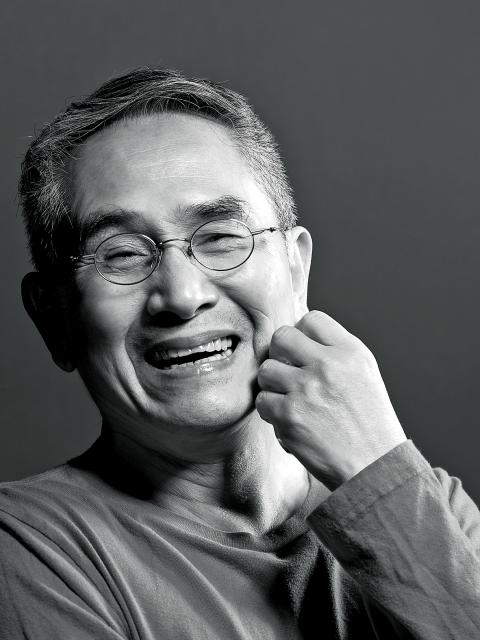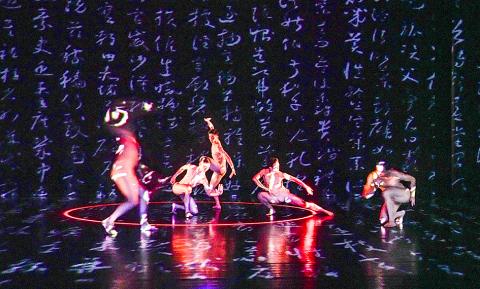Cloud Gate Dance Theatre (雲門舞集) artistic director Lin Hwai-min (林懷民) is still more than a year away from retirement, but the company and its fan base have already begun the long goodbye to a man who took his dream of a small company and produced not only a world-renowned troupe and major ambassador for the nation, but along the way helped propel Taiwan into a powerhouse of contemporary dance.
Lin forged a new path for dancers in the Chinese-speaking world by establishing the first professional company in Taiwan. The company is now celebrating its 45th anniversary, and its annual fall tour of the nation is a special gala program of highlights of the past 20 years of Lin’s works.
No one could be more surprised about reaching such a milestone than Lin himself, as he said in a telephone interview earlier this month.

Photo courtesy of Liu Chen-Hsiang
He was already a published author before entering National Chengchi University to study journalism. He left Taiwan in 1969 to study at the University of Missouri, but switched to the University of Iowa after winning a fellowship to its International Writing Program.
While he had taken some dance classes growing up, despite his father’s disapproval, it was not until age 23, while in the US, that he had the opportunity and the time to take classes regularly.
When he returned to Taiwan, he wanted to continue to dance, so he gathered a group of like-minded people, even though none of them had professional experience.

Photo courtesy of Barry Lam
Lin has said he never intended to become a choreographer; the idea was that the group would eventually be able to hire choreographers to create works for them, but in the meantime, he would try his hand. He had to teach himself how to choreograph.
However, one thing Lin and his first dancers agree on was that they wanted works that reflected their own culture, not just imitate Western modern dance. The inspiration for many Lin’s early works came from classical Chinese literature — such as The Dream of the Red Chamber (紅樓夢) — folktales and traditional theater.
The troupe’s relationship with Taiwan was cemented just five years later, in 1978, with Legacy (薪傳), the first performance of which came just as the US broke relations with Taiwan.

Photo courtesy of Cloud Gate Dance Theatre
The attachment, the feeling of ownership that Taiwanese have for Cloud Gate, its dancers and Lin, is probably unique in the world. Many countries have national troupes, but they have not been taken to heart in quite the same way.
Lin said people are always telling him about the first time they saw the company, stopping him on the street or at the theater or when he is shopping.
“When I bought the trees for the theater [in Tamsui], we saw two people jumping around back in the trees. The couple came up to talk and the wife said her husband would always buy expensive tickets to see Cloud Gate when they were dating, but after they were married he didn’t and they stopped going,” he said. “Grannies tell me about taking their grandchildren to see the company.”

Photo courtesy of Liu Chen-Hsiang
For the 45th anniversary gala program, Lin said he picked the pieces that his dancers were most comfortable with, and ones that would showcase his senior dancers, six of whom are retiring at the end of this year.
Some have been in the company for 25 years, such as Chou Chang-ning (周章佞) and Yang I-chun (楊儀君), while Tsai Ming-yuan (蔡銘元) has 19 years, Huang Pei-hua (黃珮華) and Su I-ping (蘇依屏) have 17 each and Ko Wan-chun (柯宛均) has 14.
They are the third and fourth generations of Cloud Gate dancers and they anchored the company in the early 1990s, Lin said.
“They all still love dancing, but they are tired of touring,” he said.
He said there also pieces that he wanted to put in the show, but could not, such as the end of Legacy, because the dancers have to paint their bodies black for that part, which means they could not do another piece afterwards.
“It would be nice to do the really ancient works, but hard to find the time to rehearse them. We would have had to stop everything else … we just don’t have the time,” he said, referring to the company’s busy touring schedule over the past year.
As for the line-up, “who goes first, when they go out, also depended on what else they are doing, as well as the set and costume changes,” he said.
The program will open with Chou’s solo on the character for eternal (永) from 2001’s Cursive (行草) and ends with the finale of Pine Smoke (松煙) from 2003.
In between there are a mix of solos, duets and group pieces from 2001’s Bamboo Dream (竹夢), 1997’s Portrait of the Families (家族合唱), 1998’s Moon Water (水月), 2014’s White Water (白水), 2011’s How Can I Live On Without You (如果沒有你), 2013’s Rice (稻禾) and 2006’s Wind Shadow (風.影).
The selection not only highlights the virtuosity of the dancers, but shows the variety techniques that Lin developed over the years.
“All my works are simple,” Lin said.
Many people would beg to differ.
Cloud Gate is opening its national tour at the National Theater in Taipei tomorrow night, the first of nine performances, before traveling to Taichung, Kaohsiung and Tainan.
Tickets sold fast as soon as the tour was announced this summer and there are only a few seats left.
As part of the 45th anniversary celebrations, an exhibition of the company’s posters for performances in Taiwan and overseas tours opened earlier this month at the Cloud Gate Theater in New Taipei City’s Tamsui District (淡水) and runs through Dec. 30.

With the inauguration of the Democratic Progressive Party’s (DPP) William Lai (賴清德) today, the DPP has already announced plans for increased social spending. Meanwhile the Chinese Nationalist Party (KMT) is pushing east coast infrastructure spending bills through the legislature, in part to feed and water its local patronage networks. The KMT plan is old: the first planning studies for it were done in 2012 under the Ma Ying-jeou (馬英九) administration. Even then the head of the highway administration, Wu Meng-feng (吳盟分), pointed out that on a typical weekday only 20 percent of the capacity of the east coast highways 9

Gaotai Mountain (高台山) and the three Daotian Peaks (小中大島田山回來) afford visitors a truly rewarding hike in Hsinchu County (新竹). Located in the foothills just beyond the charming Neiwan Old Street (內灣老街), the hike is well suited for hikers in a fair to good physical condition. It’s also a good introduction to the foothills of northwest Taiwan, along with some more adventurous — but still not terribly dangerous — rope and scrambling sections. As a bonus, there are Japanese ruins, hot springs and river tracing destinations such as Meihua Waterfall (梅花瀑布) and Bilin Waterfall (比麟瀑布) all located nearby. WHISPERING PINES The first section of

Like many young Taiwanese men who recently graduated from university, George Lee (李芳成) isn’t quite sure what he’ll do next. But some of his peers surely envy what he’s already achieved. During the pandemic, while staying with his brother in California, Lee started an online food page, Chez Jorge. At first, it was a straightforward record of what he cooked each day, with many of the dishes containing meat. Lee soon began to experiment with plant-based dishes, specifically vegan versions of Taiwanese dishes he was already familiar with. “Very often, I found myself awed by not only how delicious they were,

Tiffany Chang (張芳瑜) is a force to be reckoned with. Crowned Miss Taiwanese American in 2022, she made history last year as the first Taiwanese winner of Miss Asia USA. She’s also a STEM student at Stanford and an aspiring philanthropist — the kind of impressive accolades that has earned her the moniker “light of Taiwan.” At the end of March, Chang returned to Taipei, to “see the people that support me because ultimately that’s what made me win.” She says her Taiwanese supporters shower her with praise: “you inspire us, and you make us feel proud of our Taiwanese heritage,”